Vatican unveils the Holy Lance: a solemn tribute to soldier of faith St. Longinus
A canon of Saint Peter elevates the relic of the Holy Lance one last time before returning it to its chapel on Feb. 24, 2024. / Credit: Daniel Ibáñez/EWTN Vatican Vatican City, Mar 1, 2024 / 12:37 pm (CNA). The Holy Lance, also known as the Lance of Longinus, holds a significant place in Christian tradition as the weapon believed to have pierced the side of Jesus during his crucifixion. Tradition holds that the Vatican’s St. Peter’s Basilica has the jealous custody of a relic that is part of the Holy Lance. The Gospel of John provides the sole biblical reference to this event, recounting that a Roman soldier named Longinus, on the eve of the Sabbath, ensured Jesus’ death by piercing him in the side with a lance. This act, as described in John 19:34, has sparked centuries of reverence and fascination across Europe and inside the Vatican.Ministers process to the high altar, with the statue of St. Longinus in the background, on Feb. 24, 2024. Credit: Daniel Ibáñez/EWTN VaticanA soldier of faithThe story of St. Longinus has evolved into various local legends, contributing to the rich tapestry of Christianity. The city of Lanciano in the Abruzzo region asserts itself as his birthplace, claiming that his martyrdom occurred there. Conversely, Mantua in Lombardy contends that Longinus preached in the area, was martyred there, and brought relics of the Lord’s precious blood and the sponge used during the Passion to the city’s Basilica of St. Andrew. The diverse narratives surrounding St. Longinus highlight the widespread devotion and the impact of his acts recorded in the Gospel of St. John and in legends that go beyond the scriptural tradition.Liturgical commemorationThe feast of St. Longinus was historically celebrated on March 15. The Roman Martyrology, however, mentions the saint on Oct. 16 without any mention of martyrdom. The entry states: “At Jerusalem, the commemoration of St. Longinus, who is venerated as the soldier opening the side of the crucified Lord with a lance.”Statue of St. Longinus by Bernini, completed in the year 1638, is housed in St. Peter's Basilica. Credit: Daniel Ibáñez/EWTN VaticanInside the VaticanThe statue of St. Longinus, sculpted by Gian Lorenzo Bernini and housed in St. Peter’s Basilica, stands as a testament to his role in Christian history. The statue is one of four statues standing in the pillars’ niches supporting Michelangelo’s dome. In the Vatican, a special ceremony takes place in St. Peter’s Basilica during the first week of Lent. On the eve of the second Sunday of Lent — this year on Feb. 24 — the canons of St. Peter’s Basilica gather with the archpriest of the basilica, presently Monsignor Mauro Gambetti, and with concelebrating priests and the other ministers. They process to the high altar, presently under restoration, which marks the tomb of St. Peter. At the foot of the altar they meet the faithful, who are waiting for the liturgy to begin.The celebrant begins with the opening prayer and incenses the procession cross, which bears the corpus of Christ. The choir sings the Litany of the Saints until the intonation of “St. Peter, pray for us” — sung three times in honor of the “station,” which is kept on this day in Lent. (Each day during Lent, the local Church of Rome pilgrimages to a different tomb of a martyr, called the Roman Station Church pilgrim itinerary.)All gather at the foot of the high altar to start the liturgy. Credit: Daniel Ibáñez/EWTN VaticanAfter the third intonation to St. Peter, the altar servers behind the crossbearer lead the procession. They are followed by the concelebrating priests, the canons, and the celebrant. The procession goes down the nave of the basilica. Those present, the nuns and faithful alike, join in the procession, continuing to sing the Litany of the Saints. The procession continues through the basilica, culminating in the area of the altar of the chair for the holy Mass.The crossbearer leads the procession while all sing the Litany of the Saints passing Bernini’s statue of St. Longinus. Credit: Daniel Ibáñez/EWTN VaticanThe consecration and elevation of the Host during the Mass on Feb. 24, 2024. Credit: Daniel Ibáñez/EWTN VaticanAnother processionAfter the Mass, a special moment unfolds as the ministers and servers process around the high altar as the choir sings the “Stabat Mater.” The following antiphon is also sung in Latin: “Unus militum lancea latus eius aperuit et continuo exivit sanguis et aqua,” the translation of which is: “One of the soldiers opened his side with a spear, and immediately there flowed out blood and water.”Due to the work on the baldacchino of St. Peter’s, the procession this year continues around the canopy of the altar and pauses in front of the statue of St. Andrew. The clerics take off their head coverings, miters and birettas, and face the chapel above the statue of St. Veronica. A prayer is said by the canon who is about to expose the relic of the Holy Lance. He then goes to fetch the relic ac

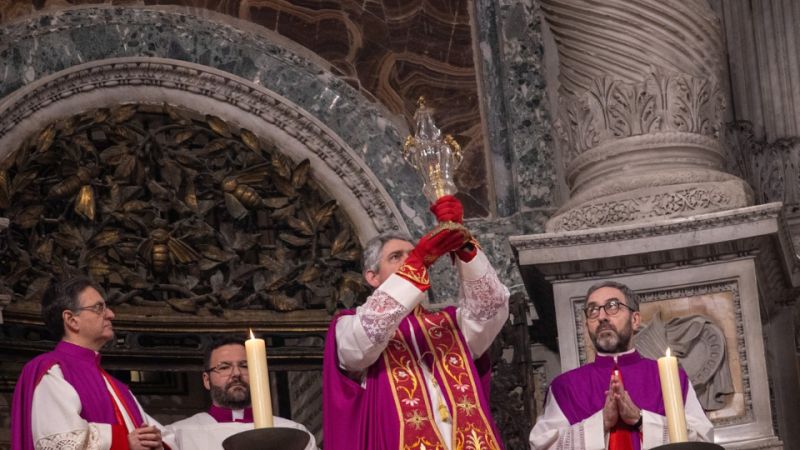 A canon of Saint Peter elevates the relic of the Holy Lance one last time before returning it to its chapel on Feb. 24, 2024. / Credit: Daniel Ibáñez/EWTN Vatican
A canon of Saint Peter elevates the relic of the Holy Lance one last time before returning it to its chapel on Feb. 24, 2024. / Credit: Daniel Ibáñez/EWTN Vatican
Vatican City, Mar 1, 2024 / 12:37 pm (CNA).
The Holy Lance, also known as the Lance of Longinus, holds a significant place in Christian tradition as the weapon believed to have pierced the side of Jesus during his crucifixion. Tradition holds that the Vatican’s St. Peter’s Basilica has the jealous custody of a relic that is part of the Holy Lance.
The Gospel of John provides the sole biblical reference to this event, recounting that a Roman soldier named Longinus, on the eve of the Sabbath, ensured Jesus’ death by piercing him in the side with a lance. This act, as described in John 19:34, has sparked centuries of reverence and fascination across Europe and inside the Vatican.
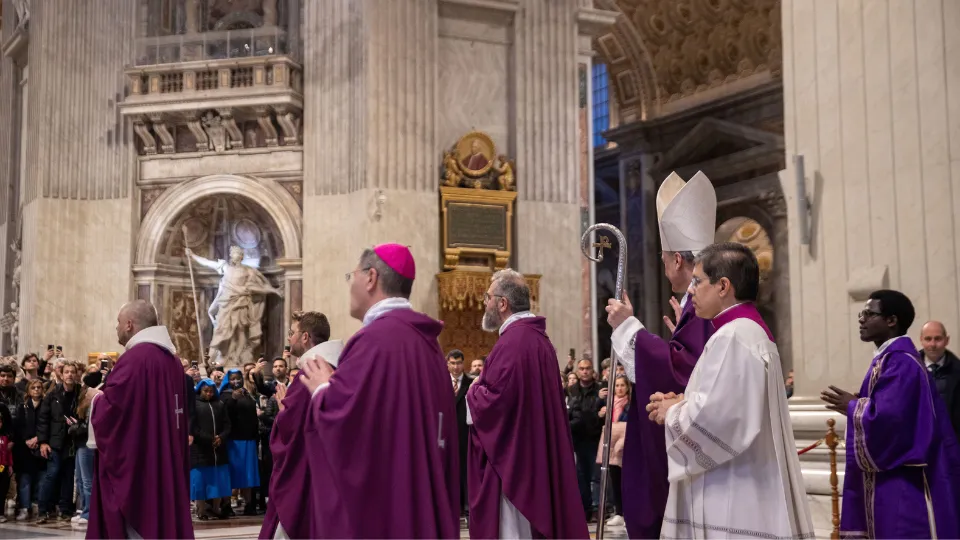
A soldier of faith
The story of St. Longinus has evolved into various local legends, contributing to the rich tapestry of Christianity. The city of Lanciano in the Abruzzo region asserts itself as his birthplace, claiming that his martyrdom occurred there. Conversely, Mantua in Lombardy contends that Longinus preached in the area, was martyred there, and brought relics of the Lord’s precious blood and the sponge used during the Passion to the city’s Basilica of St. Andrew.
The diverse narratives surrounding St. Longinus highlight the widespread devotion and the impact of his acts recorded in the Gospel of St. John and in legends that go beyond the scriptural tradition.
Liturgical commemoration
The feast of St. Longinus was historically celebrated on March 15. The Roman Martyrology, however, mentions the saint on Oct. 16 without any mention of martyrdom. The entry states: “At Jerusalem, the commemoration of St. Longinus, who is venerated as the soldier opening the side of the crucified Lord with a lance.”
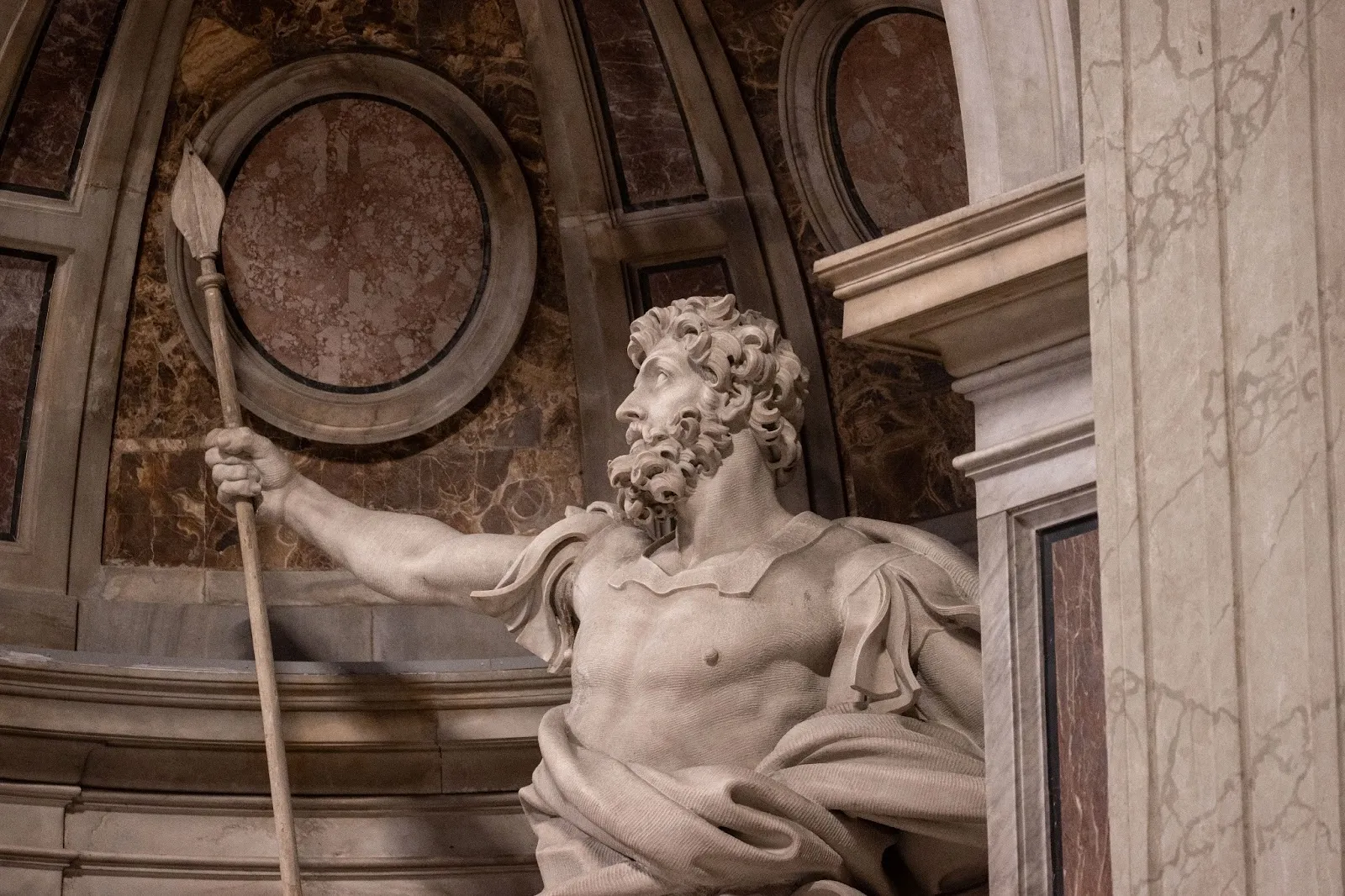
Inside the Vatican
The statue of St. Longinus, sculpted by Gian Lorenzo Bernini and housed in St. Peter’s Basilica, stands as a testament to his role in Christian history. The statue is one of four statues standing in the pillars’ niches supporting Michelangelo’s dome.
In the Vatican, a special ceremony takes place in St. Peter’s Basilica during the first week of Lent. On the eve of the second Sunday of Lent — this year on Feb. 24 — the canons of St. Peter’s Basilica gather with the archpriest of the basilica, presently Monsignor Mauro Gambetti, and with concelebrating priests and the other ministers. They process to the high altar, presently under restoration, which marks the tomb of St. Peter. At the foot of the altar they meet the faithful, who are waiting for the liturgy to begin.
The celebrant begins with the opening prayer and incenses the procession cross, which bears the corpus of Christ. The choir sings the Litany of the Saints until the intonation of “St. Peter, pray for us” — sung three times in honor of the “station,” which is kept on this day in Lent. (Each day during Lent, the local Church of Rome pilgrimages to a different tomb of a martyr, called the Roman Station Church pilgrim itinerary.)

After the third intonation to St. Peter, the altar servers behind the crossbearer lead the procession. They are followed by the concelebrating priests, the canons, and the celebrant. The procession goes down the nave of the basilica. Those present, the nuns and faithful alike, join in the procession, continuing to sing the Litany of the Saints. The procession continues through the basilica, culminating in the area of the altar of the chair for the holy Mass.

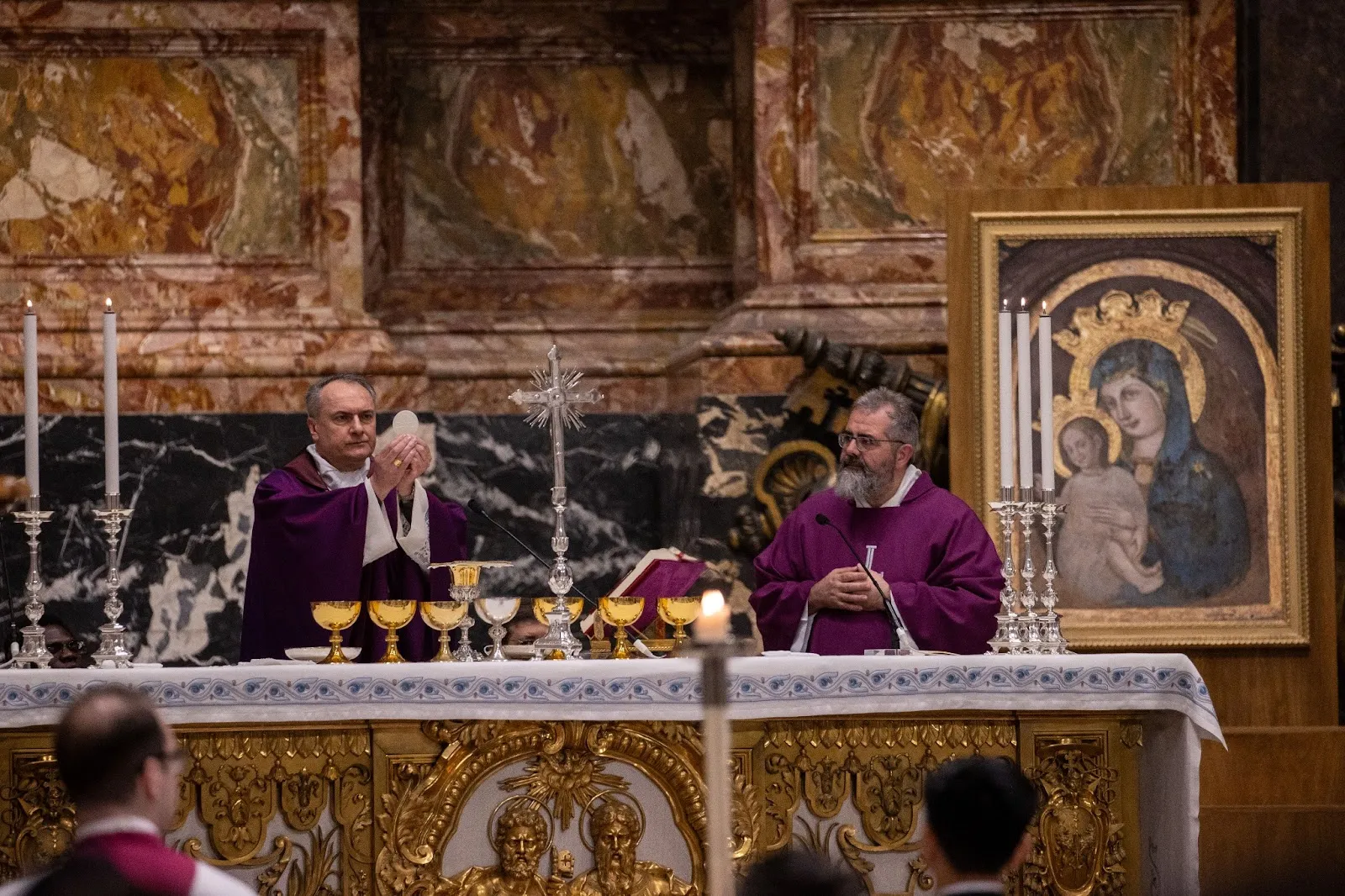
Another procession
After the Mass, a special moment unfolds as the ministers and servers process around the high altar as the choir sings the “Stabat Mater.” The following antiphon is also sung in Latin: “Unus militum lancea latus eius aperuit et continuo exivit sanguis et aqua,” the translation of which is: “One of the soldiers opened his side with a spear, and immediately there flowed out blood and water.”
Due to the work on the baldacchino of St. Peter’s, the procession this year continues around the canopy of the altar and pauses in front of the statue of St. Andrew. The clerics take off their head coverings, miters and birettas, and face the chapel above the statue of St. Veronica. A prayer is said by the canon who is about to expose the relic of the Holy Lance. He then goes to fetch the relic accompanied by two additional canons.
The bells begin to ring. Slowly, three canons exit the chapel onto the loggia, and one with red gloves carries the relic of the lance of St. Longinus. The canon, accompanied by the other two, proceeds to show the relic in all directions for the veneration of those present while the thurifer incenses the relic from down below.
The relic is shown from the center of the loggia, then to its left and its right, and back to the center to elevate the relic especially for one last glimpse.
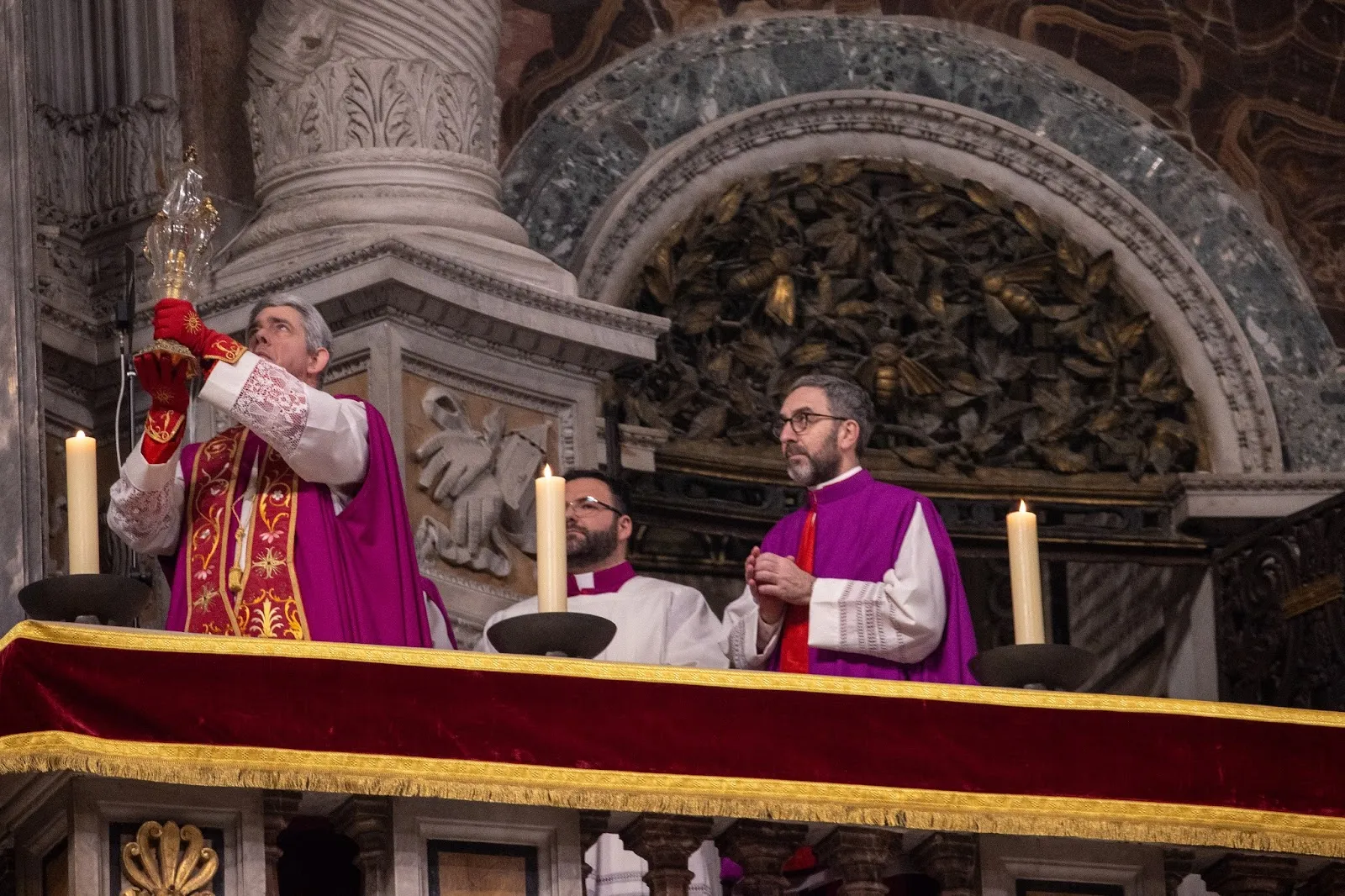
The bells sound one more time as the relic is processed back into its chapel — finally, the ministers of the Mass process to the sacristy of the basilica. Thus, the station liturgy is done.
A Lenten example
According to tradition, Longinus not only witnessed the crucifixion but also was healed of a malady of the eyes by the blood that flowed from Jesus’ side. He is also said to be the centurion who said: “Truly, this man was the Son of God” (Mt 27:54).
???? HIGHLIGHTS | Each Lent, the Vatican venerates the Holy Lance of St. Longinus relic, believed to have pierced Jesus' side. Cardinal Mauro Gambetti led the ceremony to honor St. Longinus' legacy of faith.
— EWTN Vatican (@EWTNVatican) February 26, 2024
Read more ???????? https://t.co/qJkvASpqWG pic.twitter.com/lgkdX2n6cc
In the intricate tapestry of Roman tradition, the Holy Lance and the figure of St. Longinus stand as symbols of devotion, sacrifice, and healing. The biblical reference in the Gospel of John, coupled with centuries of veneration, has woven a narrative that forms the very fabric of the Lenten experience in the local Church of the Diocese of Rome and the spirituality of St. Peter’s Basilica.
The Holy Lance continues to captivate hearts and minds, inviting believers to contemplate the profound significance of Christ’s sacrifice on the cross and to say with St. Longinus: “Truly, this man was the Son of God.”
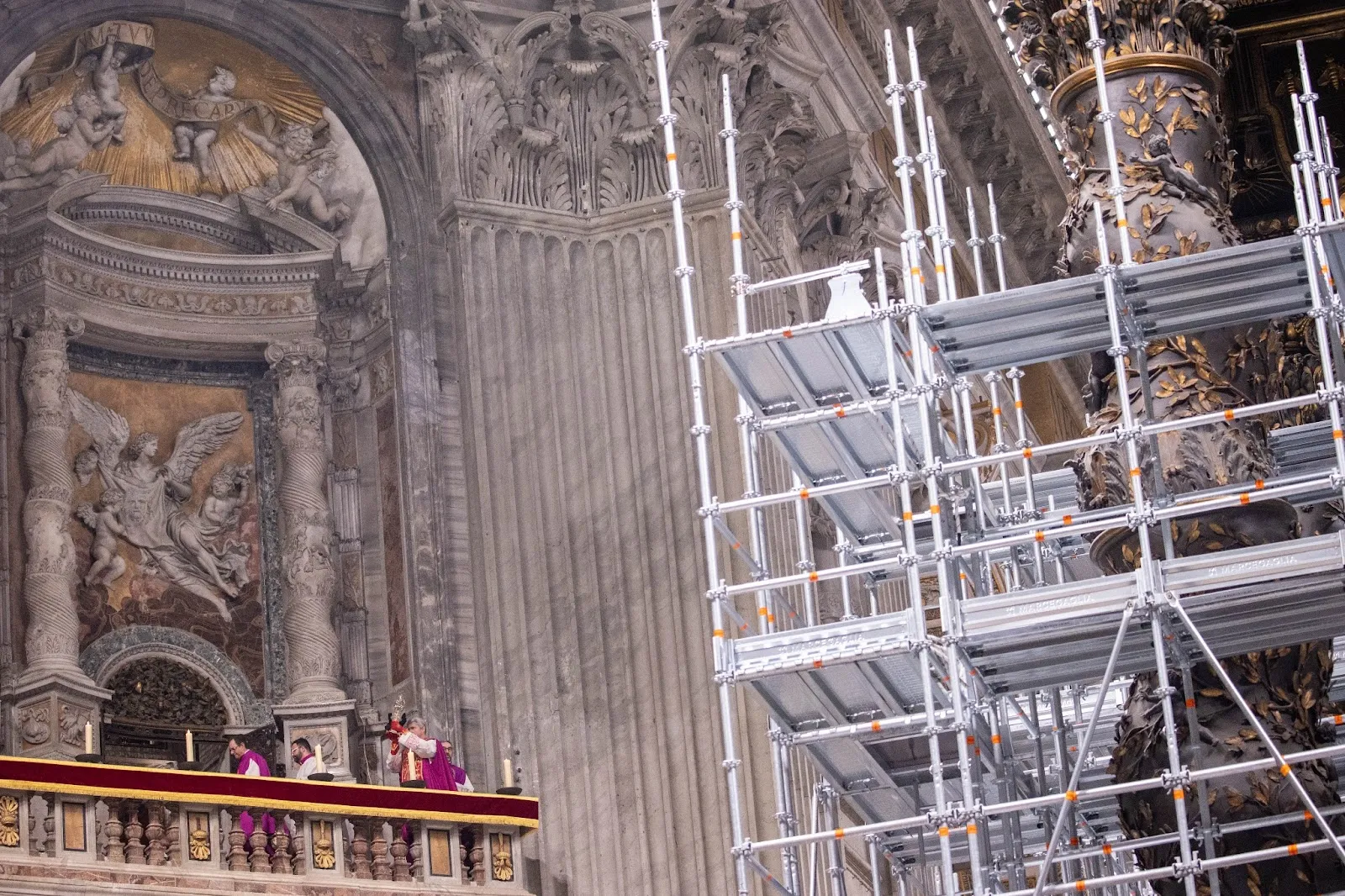
This article was originally published at EWTN Vatican, a partner of CNA.














